Are you always worried about your child spending most of his time on social media? In that case, you have all the valid reasons to worry about as social media has become a breeding ground for vulgar and cheap content that may not be appropriate for them. Especially when they’re in an age where they can not draw a clear line between right and wrong themselves, their curious minds mostly lead kids. They need to be channelized towards constructive things but can be done only in a controlled environment.
Most parents struggle to safeguard their kids against the threats that social media imposes. Since they have no control over the content openly being shared online, they end up feeling helpless. Lately, social media has become a concern for most parents resulting in stress and not just them; their kids are stressed out. It’s robbed them of their sleep and concentration in studies. But the primary concern remains inappropriate content. Ironically, the virtual world has posed some real challenges. American Academy of Child and Adolescent Psychiatry revealed that almost about 60% of children aging between 13-17 have a minimum of one social media account. Further, they stated that the children are merely mimicking their parents’ behavior as most of them frequently check their social media profiles.
Another study by Pew Research Center revealed the following facts:
- In the U.S. alone, about 94% of parents with children aging between 13-17 have either mobile, desktop, or tablet, while 76% have a smartphone and about 72% have a Facebook account.
- Nearly 84% often go online, and parents are clueless about protecting children against pornographic content and how to counsel them.
But the burning question at the moment is it the parents alone who should be worrying, or the collective onus of sharing this responsibility lies on educationists, social media houses, content developers, and cyber law enforcing agencies as well?
Parents and their children should be aware of what they have signed for when creating a social media profile. The ubiquitous use of social media has its repercussions as it may have some severe implications on your child’s privacy and safety. Social media is a place where your child is pretty vulnerable, and you have no control over it. Once you recognize this and educate your children about the same, you can safeguard them. Social media has its benefits, too; it keeps the children connected with you and their friends if they study abroad.
It also allows them to connect with like-minded people, and they can learn more in the area of their interest through each other. For instance, if your kids love camping and traveling, they can follow the itinerary shared by others on Facebook or Insta and invite more recommendations for experiencing a new camping site or trekking trails. But in the pursuit of following their passion, teens and their parents should be extra cautious as to what information should be shared publicly and what should remain within a closed group.
How Teens and Children are Targeted on Social Media
With the growing usage of social media, cybercrime has emerged as a new age tool for predators. Social media has become the gateway to connecting to vulnerable children who are often found either playing online on gaming sites or checking out their Facebook, Insta, Twitter accounts.
You’ll be surprised to know that most online predatory behavior occurs on social media and gaming sites, termed as “online grooming.” Usually, the groomers, who are adults in most cases, try to build a rapport with your child initially. They either do not reveal their age at all or lie about it. They take personal information about the children by asking general questions like their age, interests, hobbies, favorite clothing, song, etc. Later, they use this information in their conversations to relate to the child. Usually, the discussions are very generic and innocent but highly deceptive with a hidden agenda. This strategy pushes the children to the point that they start believing that no one understands them better than the predator.
Once the trust is established, the predator or the groomer starts exploring children’s sexual inclination by sharing porn stuff involving children, making them believe they are free of their choices and adult status.
Inappropriate and Harmful Content
Children who are frequently online are the ones who can be easily lured and are potentially the soft targets of predators. These children are vulnerable and susceptible to inappropriate and vulgar content given their limitless exposure to social media. Ofen druggists and alcoholics tout on porn and are a threat to children on social platforms. Paternal supervision, setting boundaries, time-line, access control, and website filters are strategies for restricting malicious content.
Cyber Bullying
Given the increasing cyber-bullying cases, the U.S. government has a hotline number# 1-800-273-TALK (8255) and a website to address cyberbullying issues StopBullying.gov. The website collates data from various government-run agencies and clarifies what falls under the purview of cyber-bullying and what can be done about it? The crisis counselor is just a call away who is equipped to deal with cyber-bullying and can empower you to deal with the situation.
Making Friends Online
Teens play smart and choose the easy way out; they keep themselves busy binging online and gaming post-school hours until bedtime. After finishing home-assignments, they sneak away, checking out their phones, texting friends, chatting online, trolling, and scrolling through various sites throughout the day and at times all through the night. It appears as if a lot is missing in gathering real-time experiences and virtual interactions predominating their lives. In the words of Dr. Catherine Steiner-Adair, a renowned clinical psychologist: ” As a species, we are very highly attuned to reading social cues,” quoted from her book “The Big Disconnect.” Undoubtedly, kids miss out on crucial social skills- they need to interact in person, learn to read body language, expressions, express feelings, respond in real-time, etc. Online communications have created a type of non-verbal disability leading to invisibility.
A significant part of growing up is making friends; given the exposure to social media in the current scenario, many children interact with people online. The virtual world disconnects them from reality, as the friends they chat with may not share their real age, name, gender, or anything about them. They may consider unreal strangers to be their best acquaintances. However, the same people may see a potential soft target in your children. Children start navigating and texting online due to specific factors. Firstly, the free access to the internet at all times, working parents spending less time with the kids, so children start to miss on real-time conversations pushing them to the zone where they start feeling comfortable interacting with strangers online risking their safety.
Sharing Images and Photos That Kids Will Regret
Children often share images on social media mindlessly without thinking through the implications in the future. Parents and educational institutions should remind them that sharing inappropriate content like images, comments, and social media links can lead to rejections in schools, universities, financial award applications, and jobs.
Conclusion
Most parents are worried about their children spending their significant time on social media, making them susceptible to inappropriate content. But often, parents forget that children imitate their parents’ behavior. So, to safeguard their children against vulgar content and sexual abuse online, firstly, they should limit their social media usage and, secondly, educate the children about possible threats online. Social media is an excellent platform to increase knowledge if used wisely. This is the discretion adults and teens need to apply for a fruitful online experience.

